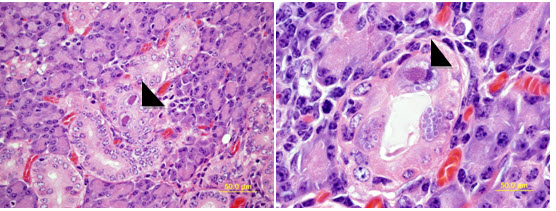Etiology: Guinea pig Cytomegalovirus (GPCMV) is an enveloped DNA virus and a member of the beta herpesvirus subfamily. CMV causes acute and latent infections in multiple species, each CMV is host-specific and is identified by animal host.
Incidence: Incidence of GPCMV is common.
Transmission: The virus is transmitted by horizontal (direct contact with saliva or urine) and vertical routes. This virus can remain latent for the life of animal.
Clinical Signs: Acute disease is usually subclinical. In pregnant sows, clinical signs include abortion storms and variable mortality. This virus is associated with immunosuppression.
Pathology: Lesions of systemic disease may not be noticed unless an animal is young or immunosuppressed and may include multifocal coagulative necrosis in the liver and spleen associated with intranuclear and intracytoplasmic inclusions. There is karyomegaly with large inclusions in the nucleus of infected cells.
There may be evidence of interstitial pneumonitis.
In subacute and chronic infections, viral replication can be seen in the ductal epithelium of the submandibular salivary gland with inclusions in the ductal epithelium (arrowheads) and lymphocytic infiltrates around ductules following primary infection.

Diagnosis: Diagnosis can be made by histologic documentation of viral-infected tissues. Serology by MFI and IFA is the best method to screen breeding colonies. PCR may be useful for confirmation of acute and latent infections.